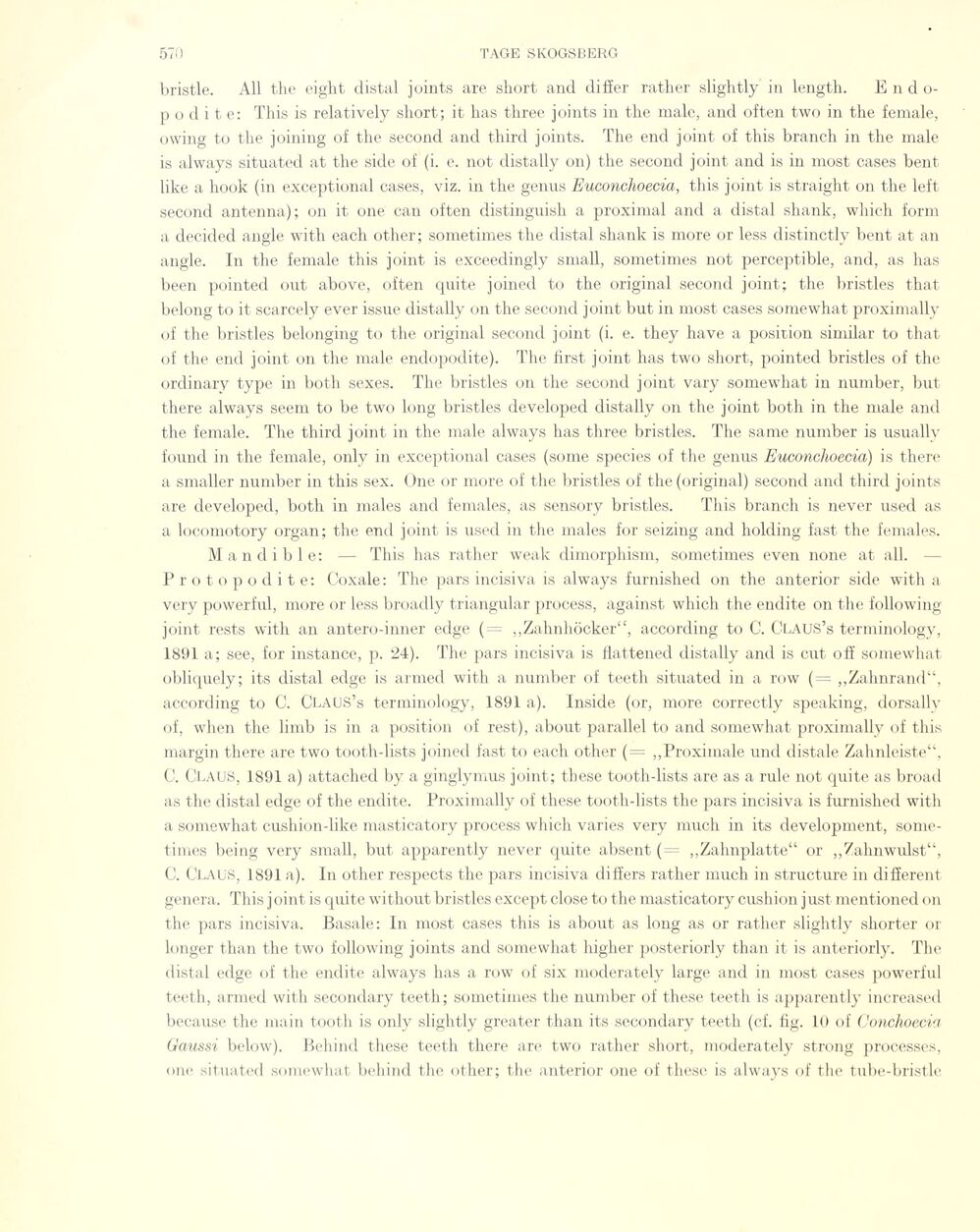
Full resolution (JPEG) - On this page / på denna sida - Sidor ...

<< prev. page << föreg. sida << >> nästa sida >> next page >>
Below is the raw OCR text
from the above scanned image.
Do you see an error? Proofread the page now!
Här nedan syns maskintolkade texten från faksimilbilden ovan.
Ser du något fel? Korrekturläs sidan nu!
This page has never been proofread. / Denna sida har aldrig korrekturlästs.
bristle. All the eight distal joints are short and differ rather slightly in length.
Endo-p o d i t e: This is relatively short; it has three joints in the male, and often two in the female,
owing to the joiniug of the second and third joints. The end joint of this branch in the male
is always situated at the side of (i. e. not distally on) the second joint and is in most cases bent
like a hook (in exceptional cases, viz. in the genus Euconchoecia, this joint is straight on the left
second antenna); on it one can often distinguish a proximal and a distal shank, which form
a decided angle with each other; sometimes the distal shank is more or less distinctly bent at an
angle. In the female this joint is exceedingly small, sometimes not perceptible, and, as has
been pointed out above, often quite joined to the original second joint; the bristles that
belong to it scarcely ever issue distally on the second joint but in most cases somewhat proximally
of the bristles belonging to the original second joint (i. e. they have a position similar to that
of the end joint on the male endopodite). The first joint has two short, pointed bristles of the
ordinary type in both sexes. The bristles on the second joint vary somewhat in number, but
there always seem to be two long bristles developed distally on the joint both in the male and
the female. The third joint in the male always has three bristles. The same number is usually
found in the female, only in exceptional cases (some species of the genus Euconchoecia) is there
a smaller number in this sex. One or more of the bristles of the (original) second and third joints
are developed, both in males and females, as sensory bristles. This branch is never used as
a locomotory organ; the end joint is used in the males for seizing and holding fast the females.
Mandible: — This has rather weak dimorphism, sometimes even none at all.
Protopodite: Coxale : The pars incisiva is always furnished on the anterior side with a
very powerful, more or less broadly triangulär process, against which the endite on the following
joint rests with an antero-inner edge (= „Zahnhöcker“, according to C. Claus’s terminology,
1891 a; see, for instance, p. 24). The pars incisiva is flattened distally and is cut off somewhat
obliquely; its distal edge is armed with a number of teeth situated in a row (= „Zahnrand“,
according to C. Claus’s terminology, 1891 a). Inside (or, more correctly speaking, dorsallv
of, when the limb is in a position of rest), about parallel to and somewhat proximally of this
margin there are two tooth-lists joined fast to each other (= „Proximale und distale Zahnleiste“,
C. Claus, 1891 a) attached by a ginglymus joint; these tooth-lists are as a rule not quite as broad
as the distal edge of the endite. Proximally of these tooth-lists the pars incisiva is furnished with
a somewhat cushion-like masticatory process which varies very much in its development,
sometimes being very small, but apparently never quite absent (= „Zahnplatte“ or „Zahnwulst“,
C. CLAUS, 1891 a). In other respects the pars incisiva differs rather much in structure in different
genera. This j oint is quite without bristles except close to the masticatory cushion j ust mentioned on
the pars incisiva. Basale: In most cases this is about as long as or rather slightly shorter or
longer than the two following joints and somewhat higher posteriorly than it is anteriorly. The
distal edge of the endite always has a row of six moderately large and in most cases powerful
teeth, armed with secondary teeth; sometimes the number of these teeth is apparently increased
because the main tooth is only slightly greater than its secondary teeth (cf. tig. 10 of Conchoecia
Gaussi below). Behind these teeth there are two rather short, moderately strong processes,
one situated somewhat behind the other; the anterior one of these is always of the tube-bristle
<< prev. page << föreg. sida << >> nästa sida >> next page >>